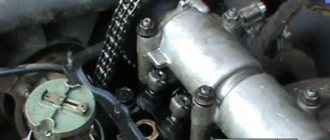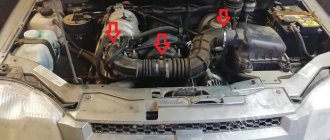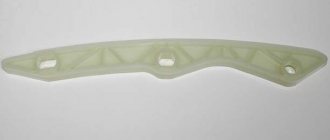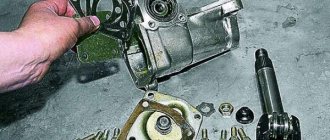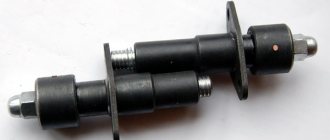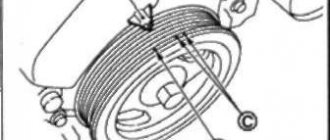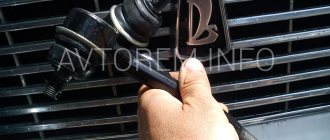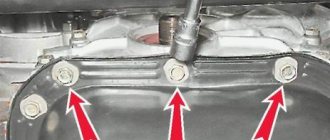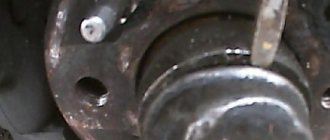Timing chain drive VAZ 2107 - description
The VAZ 2107 timing chain transmission has a long service life, but someday it’s time to replace it. The need for this arises as a result of stretching of the links, when the chain tensioner can no longer cope with the functions assigned to it. In addition, the parts responsible for the normal operation of the timing drive also wear out over time.
The main elements of the VAZ 2107 timing drive are a chain, a damper, a shoe, a tensioner and sprockets
Tranquilizer
In the chain drive of the VAZ 2107 gas distribution mechanism, a damper is used to dampen jerks and vibrations of the chain. Without this part, as the vibration amplitude increases, the chain may fly off the gears or break completely. A chain transmission break is most likely at maximum crankshaft speed, which happens instantly. At the moment of a break, the intake and exhaust valves fail. After such damage, the engine will at best require a major overhaul.
The chain damper is designed to dampen vibrations of the chain drive during engine operation.
By its design, the damper is a plate made of high-carbon steel with two holes for fastening. Another element that is simultaneously responsible for calming and tensioning the chain is the shoe. Its rubbing surface is made of high-strength polymer material.
The tensioner shoe provides chain tension, eliminating sagging
Tensioner
Based on the name, you can understand that the device is designed to prevent sagging of the timing chain while the engine is running. There are several types of such mechanisms:
- automatic;
- mechanical;
- hydraulic.
Automatic tensioners appeared not so long ago, but have already managed to show their positive and negative sides. The main advantage of the product is that there is no need to periodically adjust the chain tension, since the mechanism keeps it constantly taut. The disadvantages of the auto tensioner include quick failure, high cost, and poor tension, as evidenced by reviews from some car owners.
Hydraulic tensioners operate as a result of the action of oil under pressure, which is supplied from the engine lubrication system. This design does not require intervention from the driver in terms of adjusting the chain drive, but the mechanism can sometimes jam, which negates all its advantages.
The most common tensioner is mechanical. However, it has a significant drawback: the product becomes clogged with small particles, as a result of which the plunger jams and the mechanism is unable to perform its functions during tension adjustment.
The tensioner provides chain tension and allows for adjustments when needed.
Chain
The timing chain in the VAZ 2107 engine is designed to connect the crankshaft and camshaft: they have gears on which the chain is put. After starting the power unit, synchronous rotation of the indicated shafts is ensured through a chain transmission. If synchronization is disrupted for any reason, the timing mechanism malfunctions, resulting in the stable operation of the engine being disrupted. In such a situation, power failures, deterioration in dynamics, and increased fuel consumption are observed.
The timing chain in the VAZ 2107 engine is designed to connect the crankshaft and camshaft
As the vehicle is used, the chain stretches as high loads are placed on it. This indicates the need for periodic adjustment. Otherwise, the sagging will lead to the links on the gears jumping, which will disrupt the operation of the power unit. To prevent this from happening, the factory recommends adjusting the chain tension every 10 thousand km. mileage
Even if there are no characteristic sounds (rustling) indicating chain stretching, it is advisable to check the tension, especially since the procedure is simple and will not take much time.
Signs and causes of chain drive malfunction
The timing chain drive, unlike the belt drive, is located inside the engine and in order to assess the condition of the elements, partial disassembly of the power unit will be required. There are certain signs that indicate that not everything is in order with the chain drive and it needs to be tensioned or replaced.
The chain rattles
Problems with the circuit may manifest themselves as follows:
- rattles when cold;
- knocks on hot;
- there is extraneous noise during load;
- constant metallic sound.
If extraneous noise appears, it is recommended to visit a service station in the near future or independently deal with the problems in the timing drive and evaluate the condition of all elements responsible for its operation (tensioner, shoe, damper, chain, gears). If you continue to drive a car with a rattling chain, wear on parts increases.
Due to damage or breakdown of timing drive elements, the chain may rattle
The main reasons that lead to failure of timing belt components are:
- failure to promptly change the engine oil or use a brand other than that recommended by the manufacturer;
- use of low quality spare parts (non-original);
- low engine oil level or low pressure;
- untimely maintenance;
- improper operation;
- poor quality repairs.
One of the likely reasons that the chain begins to rattle is its stretching and a malfunction of the tensioner. As a result, the chain drive cannot be tensioned properly, and a uniform noise appears in the motor, similar to the operation of a diesel engine. In most cases, the sound is heard when idling on a cold engine.
Video: why the chain rattles on a “classic”
Jumped the chain
With low tension, the chain stretches quite quickly and can jump on the gear teeth. This is possible as a result of a broken shoe, tensioner or damper. If the chain has jumped, then a strong ignition bias occurs. In this case, it is necessary to troubleshoot the drive parts of the gas distribution mechanism.
Chain tension
Every owner of this car should know how to tension the timing chain on a VAZ 2107. To carry out the work you need to prepare:
- key to 13;
- 36mm wrench to rotate the crankshaft;
- hammer.
The procedure is carried out in the following order
- Using a 13mm wrench, unscrew the tensioner cap nut.
- Using a crankshaft wrench, turn the pulley several turns.
- Stop the crankshaft at the moment of maximum resistance to rotation. In this position we perform tension.
- We tighten the cap nut.
Video: chain tension on the “classic”
Sometimes it happens that when you unscrew the nut, the tensioner does not snap off. To do this, you need to knock on the mechanism body with a hammer.
To understand whether the chain really has good tension, you must first remove the valve cover before making adjustments.
Replacing the timing chain
First, access to the camshaft sprocket is provided, for which the valve cover is removed from the car.
Then you need to set marks on the engine. To do this, you need to turn the crankshaft by the pulley mounting bolt clockwise until the marks on the camshaft drive gear align with the mark on its housing, made in the form of a cast.
In this case, the mark on the crankshaft pulley should align with the length of the mark on the timing chain cover. If they match, you can continue working, and if not, rotate the crankshaft until all the marks match.
Then you need to unscrew the crankshaft pulley mounting bolt. For the convenience of unscrewing it, it is better to engage 4th gear at the gearbox and also use the handbrake.
After the bolt comes off, you should once again check that the marks match, and then unscrew the bolt and remove the pulley.
Related link:
How to start a VAZ engine in winter
Then you need to unscrew the bolts and nuts securing the chain cover and dismantle it. To loosen the chain tension, you can act in two ways related to the tensioner.
The tensioner itself is a small housing containing a spring-loaded rod that automatically tensions the chain. To ease the tension, you can recess the rod into the body and then fix it. But it’s easier to remove the tensioner itself along with the shoe.
After loosening the tension, you need to unscrew the bolts securing the camshaft sprocket and the auxiliary shaft sprocket, having first pressed out their lock washers with a screwdriver.
| Bend the lock washer | Unscrewing the sprocket mounting nut |
| Bend the lock washer | Tightening the sprocket bolt |
Next, the chain is removed from the auxiliary shaft sprocket, and the sprocket is also removed. Then the camshaft sprocket is removed along with the chain. These operations must be performed carefully so as not to rotate the shafts.
Having removed the camshaft sprocket, it will be possible to lower the chain slightly in order to remove it from the crankshaft sprocket. A new chain is put on in place of the removed chain, and then assembly is done in the reverse order. After installing all the sprockets, you need to check the alignment of the marks; if they have not moved, finally assemble the engine.
The mark on the crankshaft sprocket must match the mark on the block
Video on the topic: “Replacing the timing chain”
Types of chain drive
The VAZ “Seven”, like other “classics”, is equipped with a double-row timing chain. However, there is a single-row chain that, if desired, can be installed on a Zhiguli.
Single row chain
A chain drive with one row has less noise when the engine is running compared to two rows. This factor is one of the main factors in favor of choosing single-row chains. Therefore, some VAZ 2107 owners decide to replace the timing drive. The lower noise level is due to the fact that fewer links are driven. Plus, it is easier for the entire engine to rotate such a chain, which has a positive effect on the increase in power. However, due to the low noise level when such a chain is stretched, it is not always clear that the part needs tension.
Single row timing chain has lower noise levels
Double row chain
Despite the advantages of a single-row chain, a chain drive with two rows is the most common, since it is characterized by high reliability and if a link breaks, the entire chain does not break. In addition, the load on the timing drive parts is distributed evenly, as a result of which the chain and gears wear out more slowly. The life of the part in question exceeds 100 thousand km. Although recently, in order to reduce the weight of power units, automakers have been installing chains with one row.
The double-row chain, despite its higher noise level, has a long service life
Replacing a double-row chain with a single-row one
If you are thinking about replacing a double-row chain drive with a single-row one, you will need to purchase the following parts:
- crankshaft, camshaft and oil pump gears for single row chain;
- sedative;
- shoe;
- single-row chain;
- automatic tensioner.
To install a single row chain, you will need to replace the gears, chain, guide and timing chain tensioner
All of the listed parts are taken, as a rule, from the VAZ 21214. Replacing the chain should not cause difficulties. The only thing that is required is to replace the sprockets, for which you unscrew the corresponding fasteners. Otherwise, the steps are similar to the procedure for replacing a conventional double-row chain.
Replacing the camshaft chain tensioner VAZ 2105
The camshaft drive chain tensioner of the VAZ 2105 is replaced when it stops tensioning the chain, which in turn is manifested by the presence of a characteristic metallic sound in the front part of the engine, namely under the chain cover. The metallic knock of a stretched chain is especially clearly heard when the engine speed increases and, accordingly, when it decreases, it gradually disappears.
In addition, the tensioner is dismantled when performing various repairs related to disassembling the camshaft drive mechanism, for example, to replace the chain.
The tensioner is located on the right side of the engine and is attached with two bolts to the cylinder block in the area of the chain cover. On carburetor and injection engines, repair work is carried out identically. We will need a standard set of tools, namely twelve and thirteen wrenches. Once you have everything you need, you can start:
- We remove the tensioner from the car, having first unscrewed the two bolts securing it to the block and remove it from its seat. We carefully remove it, since underneath there will be a paranitic gasket, which in case of mechanical damage must be replaced with a new one. If the gasket is intact and remains on the block, then it is no longer necessary to remove it.
As if that's all, the tensioner has been removed. Now, depending on the purposes of subsequent repairs, the tensioner can be replaced with a new one or you can try to repair it yourself. For this:
- We clamp it in a vice and unscrew the cap nut completely and check the condition of the collet clamp, which is located in it. It usually happens that the clamp foot breaks, in which case it is replaced or the tensioner is changed completely.
- The tensioner also needs to be replaced if there is quite a strong wear on the plunger rod, in the place where the contact with the clamp occurs.
Having made all the necessary repairs, you can begin to install it back.
- First you need to charge the tensioner; to do this, press the plunger all the way with your finger and, holding it in this position, tighten the cap nut.
- We install it in its place and “unload” it by loosening the cap nut.
- We turn the crankshaft several revolutions in the direction of its movement (clockwise). By turning the crankshaft, the chain will tighten. Tighten the tensioner cap nut (see VAZ 2105 - how to tighten the camshaft drive chain).
At this point, the repair work to replace the camshaft drive chain tensioner on the VAZ 2105 has been completed.
